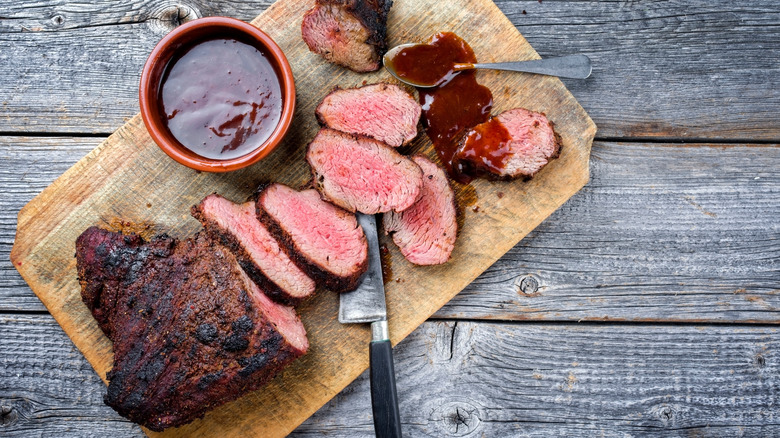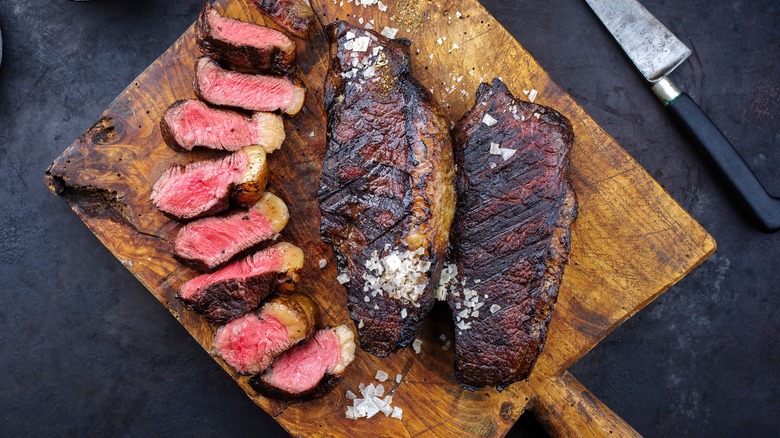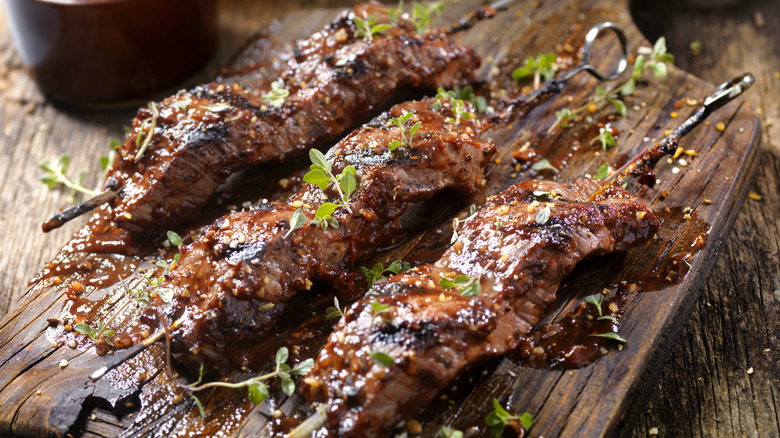The Best Use For Coulotte Steak When Cooking
Steak is an expensive meal, which makes finding the right cut of beef a crucial task. Sure, you can splurge for a glorious ribeye or an ultra-tender filet mignon, but those might not be options on most nights. Many previously overlooked cuts like hanger steak have become popular, driving their prices up in the process. Coulotte steak, however, remains a somewhat unknown cut that's packed with flavor.
While less popular in America, coulotte is a staple in Brazilian cuisine. There, it's known as picanha, and often grilled over live coals. Generally, coulotte steak responds well to high heat. It's a fairly lean cut, so it should be cooked quickly to develop a sear on the outside, while preserving a tender interior. This makes it an excellent choice for grilling, broiling, or pan-searing. Just avoid cooking it past medium-rare, as this will dry out the meat and result in a tough, chalky steak. Long cooking methods like braising should be avoided for this reason.
Despite its fairly lean nature, coulotte usually comes with a fat cap on top, which is crucial for flavor. Always begin your preparations with the fat cap facing down to allow this fat to render out during the cooking process.
How does coulotte compare to other steaks?
When an animal is butchered, it is divided into sections called primals. These primals are then broken down further into individual cuts and roasts. Coulotte comes from the sirloin primal, located above the cow's ribs and in front of its back area. Sirloin is known for its beefy flavor and well-balanced fat content, making it a popular choice for steaks.
Coulotte is similar to other sirloin cuts, though it has a character of its own. Because it is found closer to the cow's surface, it has more exposure to the air. This gives the cut more complex, dry-aged characteristics than lower sirloin cuts. It is sometimes compared to tri-tip, a cut found at the bottom of the sirloin. Both steaks are great for the grill, but coulotte features more marbling, making it more flavorful and juicier.
Perhaps the most important aspect where coulotte matches up to other steaks is its price. It is a relatively inexpensive cut that can often be found for between around $8 and $15 a pound online. Buying a whole coulotte roast (sometimes called a sirloin cap roast) and cutting it into steaks yourself can be even more cost-effective. Not every supermarket stocks it, so you may need to seek it out from your local butcher or order it online.
How to cook coulotte
In Brazil, coulotte is commonly grilled on large skewers and served with an extra-large fat cap. The cut is also a great choice for cubing and using in grilled kebabs. Pair it with fruit for Turkish steak and pomegranate skewers, or explore another South American tradition with a grilled Argentinian steak. Remember to cook coulotte over high heat to develop a crust on the outside. If it hasn't finished cooking by the time it's browned, move it to lower heat on the grill to let it reach the desired temperature.
Due to its manageable size, coulotte is also a great option for indoor cooking on your stovetop. Its smaller dimensions mean it will cook faster, avoiding the excessive smoke and splattering that can sometimes occur when cooking a steak on the stove. It's an excellent candidate for a crispy reverse sear: Cook it low and slow, then blast it with high heat for a juicy finish. After cooking, it's best to slice the coulotte before serving. To ensure tender pieces, always slice your steak against the grain, which are the muscle fibers.



